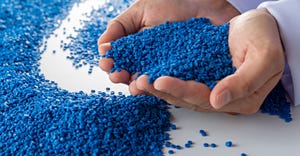Two-component molding on a one-component machine
September 3, 1998
Ever wondered if you could do coinjection ("sandwich") molding on standard single-barreled injection molding machines? Addmix Ltd. (London, U.K.) has developed a remarkably uncomplicated and affordable processing system called "sequenced screw loading" to do just that. The system feeds different-but-compatible materials through the injection unit's feedthroat in a predetermined computer-controlled sequence that is maintained as the materials travel through the shooter. The first material entering the cavity forms the aesthetically pleasing skin of the component and the second fills out the core. Any of the small degree of mixing of the two materials that might occur is buried in the core. It's that simple.
Six years in development and rigorously field-tested, system hardware consists of a volumetric metering/feeding unit for each material, a laptop running the system's Windows-based GUI, and a discrete real-time system controller. Addmix sells all of the hardware and the proprietary interactive software involved, including the laptop, and it also sells low-cost licenses. For the first year, supply of a system costs approximately $16,000, including training, installation, and licensing. Annual renewal costs $5700. No special modifications are required to molds, molding machines, screws and barrels, or molding machine control systems. It's only a computer-controlled metering/feeding system, so it does not interfere with cycle times. And the system can be moved between machines.
It's very easy to use. Addmix officials say the learning curve takes about one day, tops. The computer algorithms do all of the hard work, such as scanning and adjusting the feed-rate sequence in real time on every shot to ensure the proper results. But that's all done in the background and is invisible to the user. High cavitation can be a limitation. Officials say that balanced cavity filling is a must. In that regard, molds with more than four cavities may prove problematic. Also, the system uses up at least 50 percent of the machine's maximum shot volume to minimize mixing of the differentmaterials. And, as with other two-component molding methods, close attention must be paid to materials compatibility.
But, whether you're molding a part with a soft-touch TPO skin, or a part with an attractive colored skin over a regrind core, or even a smooth-skinned part with blowing agent in its core to improve structural strength while reducing part weight, Addmix says its system adds up to substantial savings. On-site demos can be arranged for interested parties.
Contact information |
Addmix Ltd.London, U.K.Simcha KilimPhone: +44 (181) 459-7477Fax: +44 (181) 459-7433Website: www.addmix.co.uk |
You May Also Like


